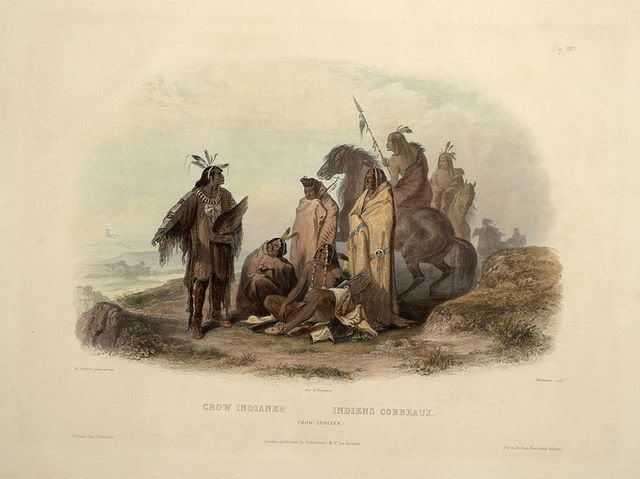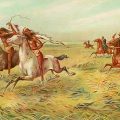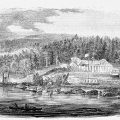
Three hundred years ago, in 1712, the European invasion of North America was underway. In the Southeast and the Southwest, the Spanish were establishing land grants to create a feudal system and missions to bring Christianity to the natives; in the northeast the English were establishing plantations and colonies on the “vacant” land they discovered; in what is now Canada, the French were actively seeking Indian trading partners; and on the Northwest coast the Russians were seeking furs and Indian slaves. In this essay, I would like to look at the interactions between the English and the Indians in 1712.
Background: The English
From the beginning of the English invasion of North America, the English colonists sought to expand English rule-English laws and English concepts of government-over the sovereign Indian nations which they encountered. With an arrogant ethnocentrism, the English viewed Indians as outsiders, living within English jurisdiction but without the full membership of citizenship. Among other things, this often meant that Indians could be punished for labor or play on the Sabbath, as well as other offenses toward the English religion.
One of the rationales used by the English for taking Indian land, or seeing it as “vacant,” was the belief that the English could put the land to “higher use” by employing European-style agriculture and livestock. It was important for the English to downplay or ignore Indian land usage and the ways in which Indians had “improved” the land. Since the Natives were already farming the land, particularly the best land, this meant that the English had to construct stereotypes of the Indians which portrayed them as nomadic hunters who did not modify or improve the land in order to justify taking the land away from them.
English policies toward Indians were based on segregation. Initially, the rationale for this segregation was based on religion: the English were Christian and the Indians were heathens. As some Indians converted to Christianity, however, that rationale for segregation became less valid. In order to continue segregation, the English came to develop the notion of “race”: changing the initial meaning of this concept which was closer to the idea of a nation, the English began to view this as a biological imperative which justified English rule.
Background: Indians
The English invaders did not encounter a single Indian empire or nation: rather, the Atlantic coast was inhabited by a number of independent Indian tribes, speaking many different languages. These sovereign Indian nations were not unified and war, primarily in the form of raids, was not uncommon.
The Indians were farmers, raising many different varieties of maize (corn), beans, squash, and tobacco. The agricultural fields were owned by the villages (that is, they were lands held in common) and worked by the women.
Initial contact with the Europeans brought diseases which were deadly to American Indians-smallpox, measles, mumps, malaria, and others. As a consequence, by 1712 the population of Indians on the Atlantic coast had been greatly reduced. In addition, English warfare with its superior weapons and focus on genocide had further reduced the Indian populations. American Indian populations on the Atlantic coast by this time were a fraction of what they had been two centuries earlier. Many tribes had already vanished, their remaining descendents absorbed into the larger tribes.
The Indians of the Atlantic coast by 1712 had adopted many items of European manufacture, particularly metal objects and cloth, and had come to rely on these items. Consequently they were involved in a symbiotic relationship with the colonists to obtain these items. No longer were the tribes self-sustaining, but they were a part of a larger, more globalized, more capitalistic, market.
With the increased reliance on European goods, Indian leadership skills also changed. The Indian leaders of 1712 needed to be able to negotiate with the English. This meant that they had to have some knowledge of English customs, religion, and language.
The Indian relationship with the land and its animals had also changed. Two centuries earlier, their agricultural economies had been supplemented by hunting. Guided by animistic concepts of harmony, the hunters harvested the animals in a sustainable fashion, using every part of the animal. As the capitalistic concept of greed entered into Indian cultures via the desire for European trade goods, including alcohol, Indians abandoned their religious concerns regarding animals and over-hunted to obtain the furs and hides which they could trade to the English. Consequently many furbearing animals, such as the beaver, became rare and the landscape began to change.
Events of 1712:
Below are some of the events from 300 years ago that characterized the interactions between the English colonists and the American Indians.
In Connecticut, English colonists declared that the Pequot had no right to the shelling and crabbing rights on their traditional lands. Pequot leader Robin Cassicinamon complained to colonial authorities. The complaint was dismissed.
He filed a complaint with the General Assembly (also known as the General Court) stemming from a law passed by the town of Groton which allotted the Pequot land at Noank. The Society for the Propagation of the Gospel in New England joined in the complaint. In its initial response to the complaint, the General Assembly ordered the town of Groton to return the land or make restitution. It also appointed a committee to resolve the complaint. The committee reported that the Pequot had abandoned the lands at Noank and moved to Mashantucket. The General Assembly concluded that the tribe had abandoned the land while retaining the fishing and hunting rights.
In the southern English colonies, the colonists continued their efforts to capture Indians who would then be sold as slaves in New England and the Caribbean. The Indians sold into slavery by the British numbers in the thousands, perhaps as many as 20,000 in 1710-1715. In North Carolina, English colonists in violation of their peace treaty attacked the Tuscarora, killing hundreds and selling many into slavery.
The British war against the Tuscarora also involved a number of British allies. The British encouraged other tribes, such as the Yamasee, Creek, and Cherokee, to attack the Tuscarora and obtain slaves for them. As early as 1710, before there were any hostilities between the Tuscarora and the British, the Tuscarora had formally petitioned the British colonial authorities for peace. Their request for peace had not been given a favorable reception.
In New York, the Iroquois Five Nations received wampum belts from the Tuscarora in the Carolinas. The Tuscarora asked for help in fighting the Catawba and the Virginia and Carolina colonists. When the governor of New York heard of the request, he warned the Iroquois not to get involved. The Iroquois promised to ask the Tuscarora to stop fighting if the governor asked the colonists to put down their arms. The French, however, convinced the Iroquois to send some warriors to aid the Tuscarora.




Leave a Reply